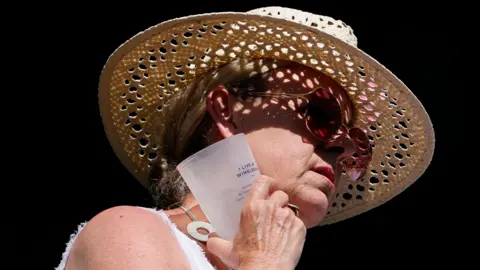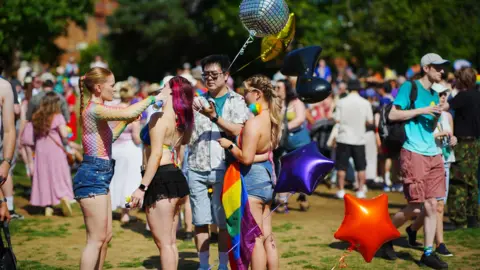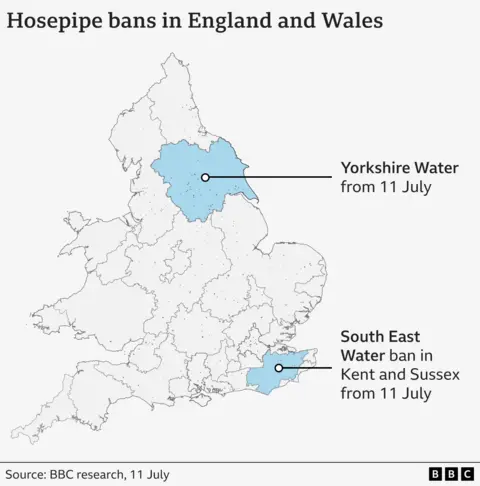 Reuters
ReutersThe UK’s third heatwave of the year peaked on Saturday afternoon, with 33C recorded in Ross on Wye.
Scotland has already recorded its warmest day of the year so far with a high of 32C – while Northern Ireland saw its hottest day in almost three years.
The latest heatwave has led to hosepipe bans being declared for millions of people in England. In Scotland, wildfire warnings are in place across much of the country.
The heat has also affected sporting events, with Wimbledon fans braving close to the hottest women’s finals day at the tennis championship.
Amber heat health alerts cover southern England – where it is hottest – until the end of the heatwave.
The Midlands, south-west England and south Wales have seen the highest temperatures – of at least 32C.
Thousands of fans travelling to a Stereophonics concert in Cardiff faced cancellations after heat damage closed a railway line.
National Rail has warned commuters of possible disruption to travel this weekend as overhead power lines and rails across Britain could be affected by the heat.
Meanwhile, a series of running events ranging from 10K to an ultra marathon in Eryri – also known as Snowdonia – were called off amid the “extreme heat”.
Temperatures hit at least 31C in Wimbledon, in south-west London, as Iga Swiatek beat Amanda Anisimova in the women’s singles final. The current record of 31.2C occurred during the 1976 women’s final.
However, the widespread nature of this heatwave means Scotland and Northern Ireland have also seen temperatures of 30C or higher.
In Perth, fire crews spent a second day tackling a wildfire, where flames could be seen creeping up a hillside.
 PA Media
PA MediaThe Scottish Fire and Rescue Service (SFRS) has issued an extreme risk of wildfire warning, urging people enjoying the outdoors to exercise caution when using a naked flame or objects made of metal or glass that could spark a fire.
The risk of wildfire is currently rated as “severe” in London by the Natural Hazards Partnership.
“Our experience tells us that wildfires can start in an instant and escalate rapidly. That’s why we’re asking everyone to stay alert and act responsibly,” the National Fire Chiefs Council (NFCC) chairman Phil Garrigan said.
Separately, fire officials warn of an increased risk of drowning when trying to keep cool, urging parents to supervise children around water at all times.
Amber heat health alerts cover from the south coast to Stoke-on-Trent and Scunthorpe will remain in place until 09:00 BST on Monday.
These signify a rise in deaths – particularly among over-65s and those with health conditions – is likely, as well as a rise in demand for health services. But it also means heat may affect people working over the weekend and pose staffing issues.
Less severe yellow warnings are in place for the rest of England – meaning the heat could affect vulnerable people.
Where are there hosepipe bans?

A hosepipe ban is in place in Yorkshire, Kent and Sussex after a particularly dry spring.
This can mean restrictions on certain activities like watering gardens, washing cars, or filling up paddling pools – and those who break the ban could face a fine.
Yorkshire’s hosepipe ban came into force for more than five million people on Friday – and is expected to last until the winter.
South East Water also introduced its ban in Kent and Sussex on Friday, and has not said when it will be lifted.
It said the region had faced its driest spring in almost 130 years and that demand for drinking water had “reached record levels” since May.
Thames Water also warned on 9 July that it could announce a ban of its own, blaming dry weather and increased customer demand.
 NASA
NASAWhile linking climate change with specific individual extreme weather events can be difficult, scientists say that climate change is generally making heatwaves hotter, longer and more frequent.
Three summer heatwaves in quick succession after an unusually warm spring suggests climate change is having some effect on 2025’s weather – impacting not just humans but wildlife as well.
When will the heatwave end?
The heat will continue into Saturday evening, with temperatures in the low to mid-20s as late as 23:00.
Sunday will see highs in many areas dip slightly but London could continue to swelter in 30C heat or above.
But the heatwave is expected to end for most on Monday, as cooler Atlantic air brings temperatures closer to the seasonal average for much of the UK.
The changed weather pattern will also bring rain to some areas, including those where rain has been seriously lacking recently.
However, those in the south-east of England may have to wait until Tuesday for some respite from the heat, with temperatures set to remain around 27C or 28C on Monday.
#Heatwave #peaks #33C #country #swelters



